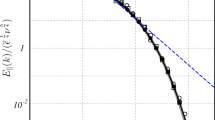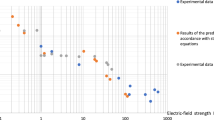Abstract
To understand the motion of particles in a turbulent magnetic field is a fundamental problem in modern physics. However, it is difficult to explore this problem analytically due to the complicated structure of such fields. In the current paper we derive constants of motion based on the Lagrangian. The special cases of slab and two-dimensional turbulence are considered. The obtained results can be used to simplify equations of motions which can lead to improved non-linear theories for particle transport. The findings are also compared with previously obtained results.
Similar content being viewed by others
Data Availability
Not applicable.
Notes
The author of this paper is grateful to the referee for pointing this out.
References
Bieber, J.W., Matthaeus, W.H., Smith, C.W., Wanner, W., Kallenrode, M.-B., Wibberenz, G.: Astrophys. J. 420, 294 (1994)
Boas, M.L.: Mathematical Methods in the Physical Sciences. Wiley, New York (2006)
Corrsin, S.: In: Frenkiel, F., Sheppard, P. (eds.) Atmospheric Diffusion and Air Pollution. Advances in Geophysics, vol. 6, p. 161. Academic Press, New York (1959)
Dosch, A., Shalchi, A.: Adv. Space Res. 46, 1208 (2010)
Dundovic, A., Pezzi, O., Blasi, P., Evoli, C., Matthaeus, W.H.: Phys. Rev. D 102, 103016 (2020)
Engelbrecht, E.N., Moloto, K.D.: Astrophys. J. 908, 167 (2021)
Engelbrecht, E.N., Wolmarans, C.P.: Adv. Space Res. 66, 2722 (2020)
Ferrand, G., Danos, R., Shalchi, A., Safi-Harb, S., Mendygral, P.: Astrophys. J. 792, 133 (2014)
Li, G., Zank, G.P., Rice, W.K.M.: J. Geophys. Res. 108, 1082 (2003)
Li, G., Zank, G.P., Rice, W.K.M.: J. Geophys. Res. 110, A06104 (2005)
Li, G., Shalchi, A., Ao, X., Zank, G.P., Verkhoglyadova, O.P.: Adv. Space Res. 49, 1067 (2012)
Matthaeus, W.H., Goldstein, M.L., Aaron, R.D.: J. Geophys. Res. 95, 20673 (1990)
Matthaeus, W.H., Qin, G., Bieber, J.W., Zank, G.P.: Astrophys. J. Lett. 590, L53 (2003)
Moloto, K.D., Engelbrecht, N.E.: Astrophys. J. 894, 121 (2020)
Qin, G., Matthaeus, W.H., Bieber, J.W.: Geophys. Res. Lett. 29, 1048 (2002a)
Qin, G., Matthaeus, W.H., Bieber, J.W.: Astrophys. J. Lett. 578, L117 (2002b)
Reimer, A., Shalchi, A.: Mon. Not. R. Astron. Soc. 456, 3803–3812 (2016)
Robinson, D., Rusbridge, M.: Phys. Fluids 14, 2499 (1971)
Schlickeiser, R.: Cosmic Ray Astrophysics. Springer, Berlin (2002)
Shalchi, A.: Phys. Plasmas 12, 052905 (2005)
Shalchi, A.: Nonlinear Cosmic Ray Diffusion Theories, vol. 362. Springer, Berlin (2009)
Shalchi, A.: Astrophys. J. Lett. 720, L127 (2010)
Shalchi, A.: Space Sci. Rev. 216, 23 (2020)
Shalchi, A.: Astrophys. Space Sci. 366, 69 (2021a)
Shalchi, A.: Astrophys. J. 923, 209 (2021b)
Shalchi, A., Bieber, J.W., Matthaeus, W.H., Qin, G.: Astrophys. J. 616, 617 (2004)
Shalchi, A., Bieber, J.W., Matthaeus, W.H.: Astron. Astrophys. 483, 371 (2008)
Shalchi, A., Škoda, T., Tautz, R.C., Schlickeiser, R.: Astron. Astrophys. 507, 589 (2009)
Tautz, R.C., Shalchi, A., Schlickeiser, R.: J. Phys. G, Nucl. Part. Phys. 32, 809–833 (2006a)
Tautz, R.C., Shalchi, A., Schlickeiser, R.: J. Phys. G, Nucl. Part. Phys. 32, 1045–1059 (2006b)
Tautz, R.C., Shalchi, A., Schlickeiser, R.: Astrophys. J. Lett. 685, L165 (2008)
Zank, G.P.: Transport Processes in Space Physics and Astrophysics. Lecture Notes in Physics, vol. 877. Springer, New York (2014)
Zank, G.P., Matthaeus, W.: J. Plasma Phys. 48, 85 (1992)
Zank, G.P., Rice, W.K.M., Wu, C.C.: J. Geophys. Res. 105, 25079 (2000)
Zank, G.P., Li, G., Florinski, V., Hu, Q., Lario, D., Smith, C.W.: J. Geophys. Res. 111, A06108 (2006)
Zank, G.P., Adhikari, L., Hunana, P., Shiota, D., Bruno, R., Telloni, D.: Astrophys. J. 835, 147 (2017)
Zank, G.P., Nakanotani, M., Webb, G.M.: Astrophys. J. 887, 116 (2019)
Zweben, S., Menyuk, C., Taylor, R.: Phys. Rev. Lett. 42, 1270 (1979)
Funding
This work was supported by Natural Sciences and Engineering Research Council (NSERC) of Canada.
Author information
Authors and Affiliations
Contributions
A. Shalchi is the sole author and did all the mathematics as well as the writing of the manuscript.
Ethics declarations
Competing interests
The authors declare no competing interests.
Additional information
Publisher’s Note
Springer Nature remains neutral with regard to jurisdictional claims in published maps and institutional affiliations.
Appendices
Appendix A: The Lagrangian in classical notation
Alternatively, compared to the Minkowski coordinates used in Sect. 2 of this paper, one can use classical notation. In this case the Lagrangian of a particle in the electromagnetic field has the form
which can also be written as
The Euler-Lagrange equations now have the form
The conservation relation, previously given by Eq. (7), turns into
where the canonical momentum is now obtained via
For the electromagnetic case (see Eq. (107)) this becomes
where we have used again the Lorentz factor \(\gamma \) as given by Eq. (29). Therefore, we find for the canonical momentum
For the Lagrangian given by Eq. (107) we now deduce the spatial derivative needed in Eq. (108)
Using this and Eq. (112) in Eq. (108) yields
With
this can be written as
The left-hand-side of this equation corresponds to the time-derivative of the relativistic momentum. In order to see that we found the correct equation of motion, we need to express the right-hand-side by the components of the electric and magnetic fields. To do this we consider
as well as
Combining the latter two equations yields
Using the property \(\epsilon _{nij} = - \epsilon _{nji} = \epsilon _{jni}\) of the Levi-Civita symbol allows us to write this as
This can be simplified by employing the well-known relation (see, e.g., Boas (2006))
Therewith, we find
In the latter formula we rename \(n \rightarrow i\) and \(i \rightarrow j\) so that we obtain
This can be used in Eq. (116) to derive
Finally we can replace the remaining potentials by the electric field as given by Eq. (22) so that
in perfect agreement with the Newton-Lorentz equation.
As an example we consider the magnetostatic and two-dimensional case where \(A_{i} = A_{i} (x,y)\) and, thus, it follows from Eq. (109) that
Therefore, we find by using Eq. (112)
in agreement with Eq. (48).
Appendix B: Alternative investigation of particles in slab turbulence
In the main part of this paper it is stated that no constant of motion can be found for particles moving through slab turbulence with mean magnetic field unless one uses guiding center coordinates (see Sects. 4.2 and 5). The considerations presented in Sect. 4 are based on Eq. (40) for the vector potential of the mean field. However, there are alternative forms of the vector potential leading to a constant mean field pointing into the \(z\)-direction.Footnote 1 One of such alternatives is \(\vec{A} = B_{0} x \hat{y}\). For this form the total vector potential of slab turbulence and a mean field is given by
instead of Eq. (50). Therefore, there is no \(y\)-dependence of the total vector potential and conservation law (18) turns into
Using this result in Eq. (17) yields
With the above vector potential this can be written as
Alternatively, this can be written as
Or, with the help of Eq. (57), we can write this as
Although this corresponds indeed to a constant of motion, the result is not particularly useful. However, one can use again guiding center coordinates (we use the first line of Eq. (60)) to derive
in perfect agreement with Eq. (70). Therefore, we simply found an alternative derivation for an already known result.
Furthermore, one could use \(\vec{A} = - B_{0} y \hat{x}\) for the potential of the mean magnetic field. After performing the same steps as above, one then arrives at
Using again guiding center coordinates yields Eq. (71).
Rights and permissions
Springer Nature or its licensor holds exclusive rights to this article under a publishing agreement with the author(s) or other rightsholder(s); author self-archiving of the accepted manuscript version of this article is solely governed by the terms of such publishing agreement and applicable law.
About this article
Cite this article
Shalchi, A. Constants of motion in the theory of energetic particles propagating through magnetic turbulence. Astrophys Space Sci 367, 93 (2022). https://doi.org/10.1007/s10509-022-04131-9
Received:
Accepted:
Published:
DOI: https://doi.org/10.1007/s10509-022-04131-9




